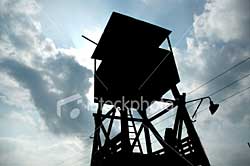Keeping Watch : Effectively
Intrusion detection system provides some protection to treatment facilities
- By Steve Kovacs
- Jul 01, 2007
 Municipalities across
the country are
realizing that protection
of water
resources deserves
an increased priority
and focus. The cost and consequences of
contamination as a result of a mischievous child,
a vagrant wandering onto the property, or a terrorist
looking to inflict maximum harm can be
catastrophic. The typical chain-link fence with
razor wire is nothing more than a simple physical
barrier most 12-year-olds can easily defeat.
Municipalities across
the country are
realizing that protection
of water
resources deserves
an increased priority
and focus. The cost and consequences of
contamination as a result of a mischievous child,
a vagrant wandering onto the property, or a terrorist
looking to inflict maximum harm can be
catastrophic. The typical chain-link fence with
razor wire is nothing more than a simple physical
barrier most 12-year-olds can easily defeat.
Perimeter protection is important for water
treatment facilities, and systems providing that
protection should:
• be adaptable, given that perimeters vary
from site to site.
• have a false/nuisance alarm rate as close to
zero as possible. The cost of responding to false
and nuisance alarms can quickly reduce the benefit
of having an intrusion detection system.
• present an imposing message to would-be
intruders, yet be aesthetically pleasing to
the surrounding environment.
• communicate exactly where a perimeter
breach is taking place.
• be easy to maintain and be easily repaired,
if needed.
• be affordable.
Sensing security
A guard tower system can help meet perimeter
protection challenges. The system consists of a
vertical sensing post attached to a wire array. The
sensing post can be mounted at various heights
and to various supporting surfaces. Each sensing
post has a unique address location.
When
activated, the alarming post sends a signal to the
head-end control, identifying itself and the
breach location. The sensing post monitors the
movement of the wires in the wire array—any
significant movement of the wire in any direction
activates the alarm sensors.
In addition to the guard tower systems’ ability
to be configured many different ways, the
head-end controls also offer different options,
depending on user requirements and budget. A
computer-based control reads the information
transmitted from the sensing post. Based on user
inputs, the control will trigger an alarm condition,
a relay-based standard alarm panel annunciates
alarms either to an alarm panel with LCD
keypad, or interfaces with an existing access control
system, and a computer-based control with
plug-and-play CCTV integration directs cameras
to target the breach point, providing immediate
visual verification.
Reaction action
A well site in the middle of a residential area
recently was threatened by vandalism. The intruders
were breaching a 3-foot, wrought-iron fence
mounted on top of a 6-foot-high brick wall.
The user chose to install a 3-foot guard tower
system using the relay-based control head-end
integrated with an existing SCADA (supervisory
control and data acquisition) control.
The
guard tower was mounted behind the existing
wrought-iron fence and was selected because it:
• offers close to zero false/nuisance alarm rate,
• aesthetically fits with the environment,
• has the ability to mount to both a sliding
and swing gate,
• integrates with the existing SCADA controls
and
• is certified to withstand a saltwater-spray
environment.
“Most fences are just hardened physical security—
they don’t have intrusion detection capabilities,”
said a municipality utilities manager
using the system. “Our intent was never to keep
intruders out; rather we want to know that they
are trying to get in. We have major concerns
about vandalism. With the intrusion detection
capabilities of the guard tower system, we
know something is going on and, more importantly,
precisely where it is happening.
“With the guard tower intrusion detection
system we have had no false alarms. Our confidence
in the system is high, and staff members
feel they can trust it. Police will automatically
respond because it is a smart
intrusion detection system and any alarm from
it is considered validated. This is important,
as it does not require a staff member to drive
to the site and verify the cause of the alarm
prior to police response.”
At another site—a large water treatment
facility—located in a harsh environment where
snow and below-zero temperatures caused problems
for previous perimeter protection systems,
an 8-foot-tall standalone guard tower system
with sensor posts spaced at 40-foot increments
behind an existing chain link fence was chosen.
An unsupervised public park adjacent to the site
would attract people who would breach the
perimeter on a regular basis.
The guard tower intrusion detection system
was selected because it solved such problems
as minimal or no false/nuisance alarms in an ice
and snow environment, the ability to pinpoint
breach attempts, and because it was aesthetically
pleasing and fit the environment. It also was
found to be cost effective, and the head-end control
networks plugged into the existing LAN
(local area network).
This article first appeared in an April 2007 supplement of Security Products, an 1105Media Inc., publication.
This article originally appeared in the 07/01/2007 issue of Environmental Protection.
About the Author
Steve Kovacs is the director of business development for Zareba Security. He can be reached at (952) 292-4351.